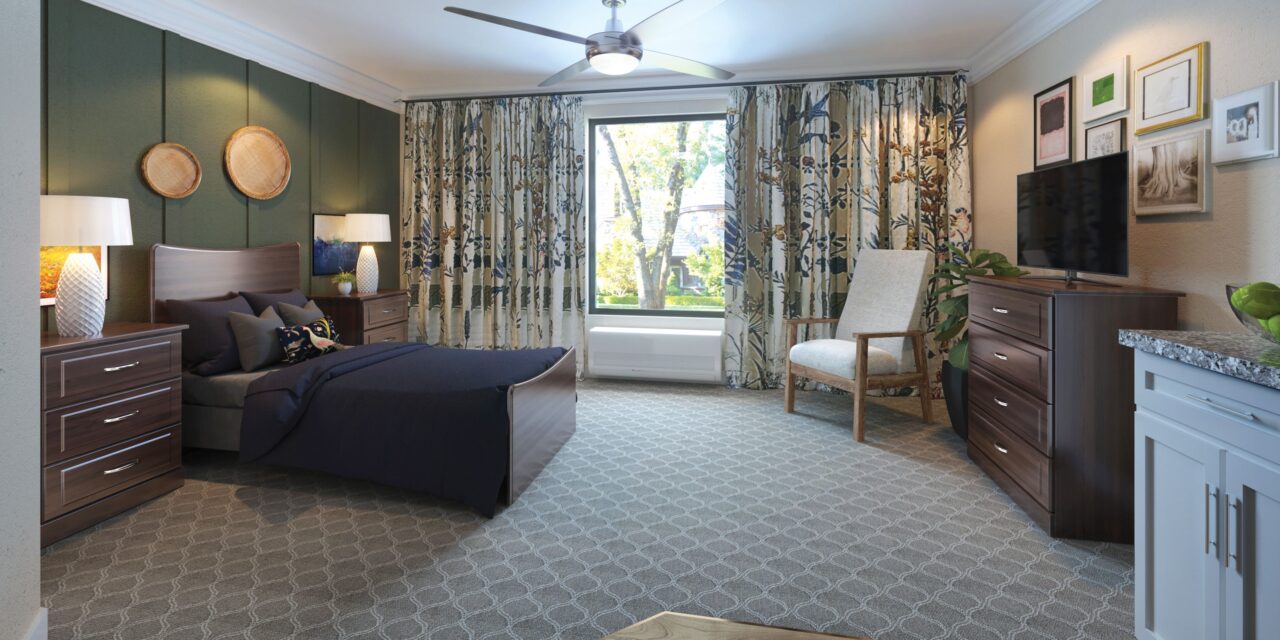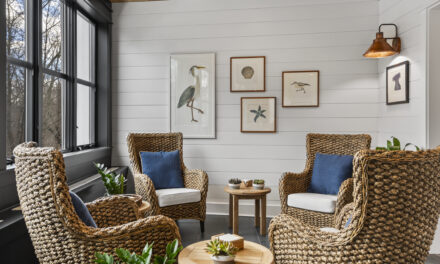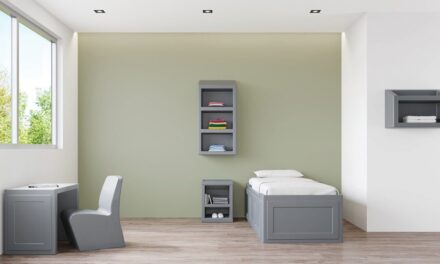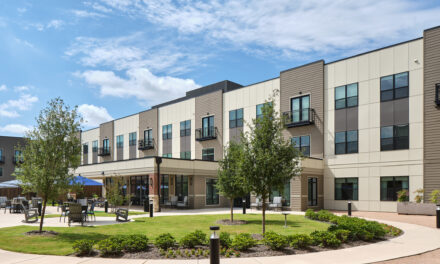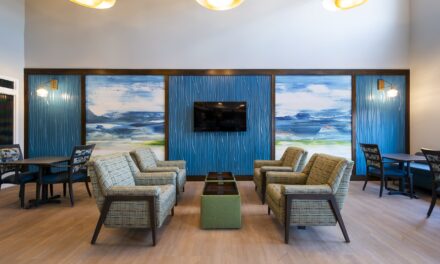Pictured above: Akin Brookhaven Collection. ( 3-Drawer Bedside Cabinet, 4-Drawer Chest, High Back Resident Room Chair ) Also pictured: Akin Modern Bed Panels, 36″W. Contact us for pricing.
Senior Living bedrooms are the building block of a community – it’s essential residents feel relaxed and comfortable in their own space. Designing senior-savvy bedrooms with safe and stylish senior furniture will increase satisfaction for residents and family members, and boost the community’s marketability. Here are five considerations for resident room design:
1. Choose calming colors
Create a relaxing atmosphere in Assisted Living and Independent Living environments with calm and soothing colors, like cool blue, green hues and natural tones. Choosing softer shades instead of brighter tones can help the space feel like home. Find more tips for 2022 color trends and how to use them in Senior Living design.
Colors are especially important in Memory Care environments. For residents with dementia, dark colors may appear as a hole or missing space. Consider using darker shades purposefully when creating a walking path or an area that residents should avoid.
Help differentiate between major pieces of furniture, walls, drapes and floors with color contrast. Contrasting colors on furniture details, like cording, piping or nailhead detail helps outline furniture. This approach is also helpful for different pieces of bedding. Using a combination of materials and colors can help aging eyes better distinguish their environment.
Also select contrasting colors in window treatments to help make them stand out from the wall. Choose window treatments that foster ample natural light. Not only does natural light provide improved visibility, it can also have a positive impact on sleep cycles and mood.
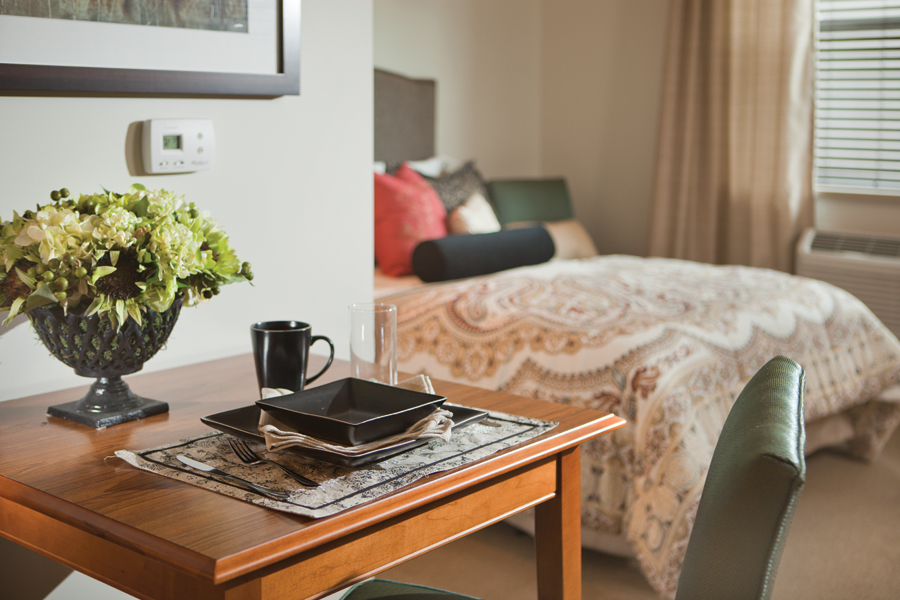
2. Optimize Resident Room spaces
Reduce Resident Room Occupancy
Single-resident rooms in nursing homes enhance privacy, feelings of home and sense of control. On February 28, 2022, the Biden administration announced new steps being taken by the Department of Health & Human Services through its Centers for Medicare & Medicaid Services (CMS), to improve the quality and safety of nursing homes to protect vulnerable residents and the health care heroes who care for them. These steps included ones to reduce resident room crowding.
“Most nursing home residents prefer to have private rooms to protect their privacy and dignity, but shared rooms with one or more other residents remain the default option. These multi-occupancy rooms increase residents’ risk of contracting infectious diseases, including COVID-19. CMS will explore ways to accelerate phasing out rooms with three or more residents and to promote single-occupancy rooms.” 1
Reducing resident room occupancy improves resident wellness and overall marketability. Convert multi-resident rooms to individualized, person-centered homes that promote safety and resident well-being.
Why reduce resident room occupancy?
- Limit exposure and risk of infection beyond Covid-19, including influenza and mrsa
- Elevate marketability to prospective residents and their families
- Reduce risk of resident anxiety and incidences of aggressive behavior
- Improve resident sleep
- Enhance privacy, feelings of home and sense of control for your residents
- Decrease risk of medication errors
Learn more about the benefits of reducing resident room occupancy.
How to achieve lower resident room occupancy:
- Remove extra beds, furnishings or equipment to convert a 2-bed room to a private room
- Add dividers or temporary walls to create more division between residents than a just curtain can provide
Achieve Efficiency in Resident Rooms
When space is limited, it’s important to take a creative approach to ensure it’s easy for seniors to get around the room. Think about the resident’s journey through the room each day, and arrange the floor plan accordingly. This helps with resident safety, caregiver usability and aesthetics.
Choose casegoods that offer ample storage. Avoid tripping hazards and keep cords organized with casegoods that feature cut-outs for cables and built-in charging stations. Place pop-up outlets in desks or countertops, or choose furnishings with built-in USB ports.
If natural light is limited, incorporate lighting fixtures that can change throughout the day. Start with ambient light in the morning, brighter light in midday and then dimmed light at dusk to coordinate with the circadian rhythm and improve sleep patterns. Like color, adapting the lighting in senior bedrooms helps reduce risk of anxiety and improves mood.
Even in rooms with limited space, creating individualized, person-centered homes that are safe and comfortable is important. Digital picture frames are a great option to help limit clutter in a small space and add a touch of personalization.
Customizable chairs, like the Maxwell Thomas Ridgeland Tub Chair, are ideal for smaller areas because of the custom features, like cup holders, activity tables and power outlets. Create spaces within the room that feel like a separate living space by choosing furnishings that provide comfort with motion, like the Maxwell Thomas Silverthorne Rocker. Discover more furniture for Senior Living facilities.
3. Personalize with accessories
When it comes to resident room interior design, on-trend accent lighting, decorative pillows and soft, organic window treatments can help create a welcoming ambiance. Include residents’ accessories from home — like photographs, keepsakes and favorite blankets to help personalize the space.
Consider adding live plants in resident rooms and asking residents to care for the plants themselves. For other ideas on engagement opportunities for your residents, read 5 Ways Design can Foster Memorable Experiences.
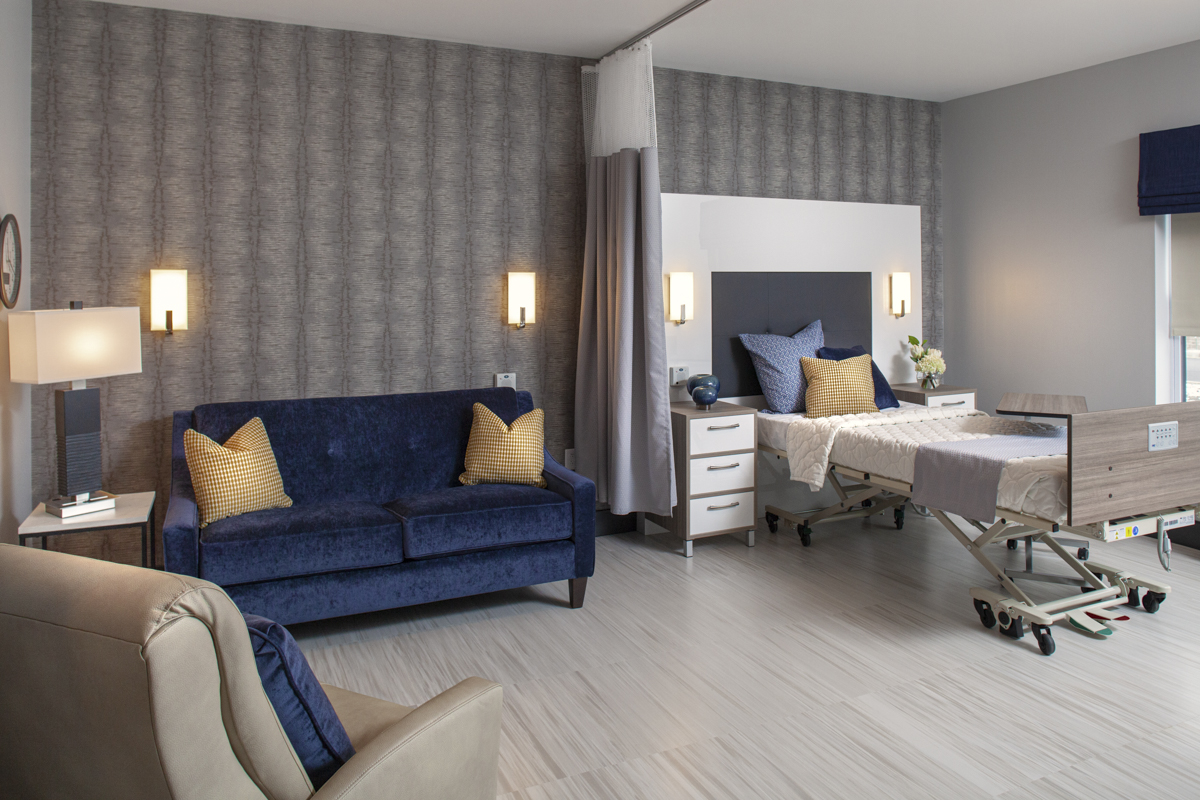
4. Select durable furnishings
Achieve a residential look with comfortable and supportive accent seating for family and friends. If space allows, include furnishings to create a living room and dining room within the resident suite.
Adding a matching casegoods collection can help create a cohesive feel. Senior Living casegoods are an essential part of any resident room. If you’re unsure which material you should choose for casegoods, there are a few options to consider based on your community’s needs and preferences.

Veneer
Upscale veneer construction is warm and inviting, and it often features high-pressure laminate tops that resist moisture and spills. Its unique features make it perfect for hospitality-inspired and transitional care environments. Check out the Maxwell Thomas® Ridgeland Collection, a residential-inspired veneer collection. Shop all Veneer bedside cabinets.
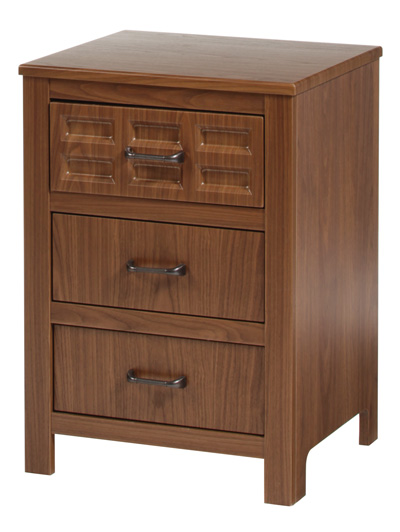
Thermolaminate
Seamless surfaces are highly resistant to moisture, denting, cracking, chipping and peeling for a fresh look that will last in demanding settings like Memory Care. The Maxwell Thomas® Evanston Collection features durable thermolaminate construction and an Arts and Crafts style. Shop all Thermolaminate bedside cabinets.
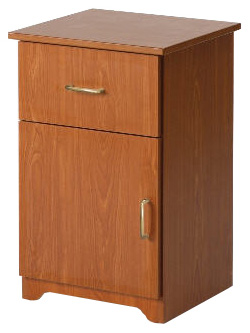
Laminate
This budget-conscious option is available in a spectrum of styles so you don’t have to sacrifice the look you want for the price point you need. Plus, high-pressure laminate tops add durability where you need it most. Discover high-end laminate in the Maxwell Thomas® Plymouth Collection. Shop all Laminate bedside cabinets.
Hekman Reveal 3-Drawer Bedside Cabinet with Reveal Top Drawer pictured. Product features laminate surfaces with durable high-pressure laminate tops.
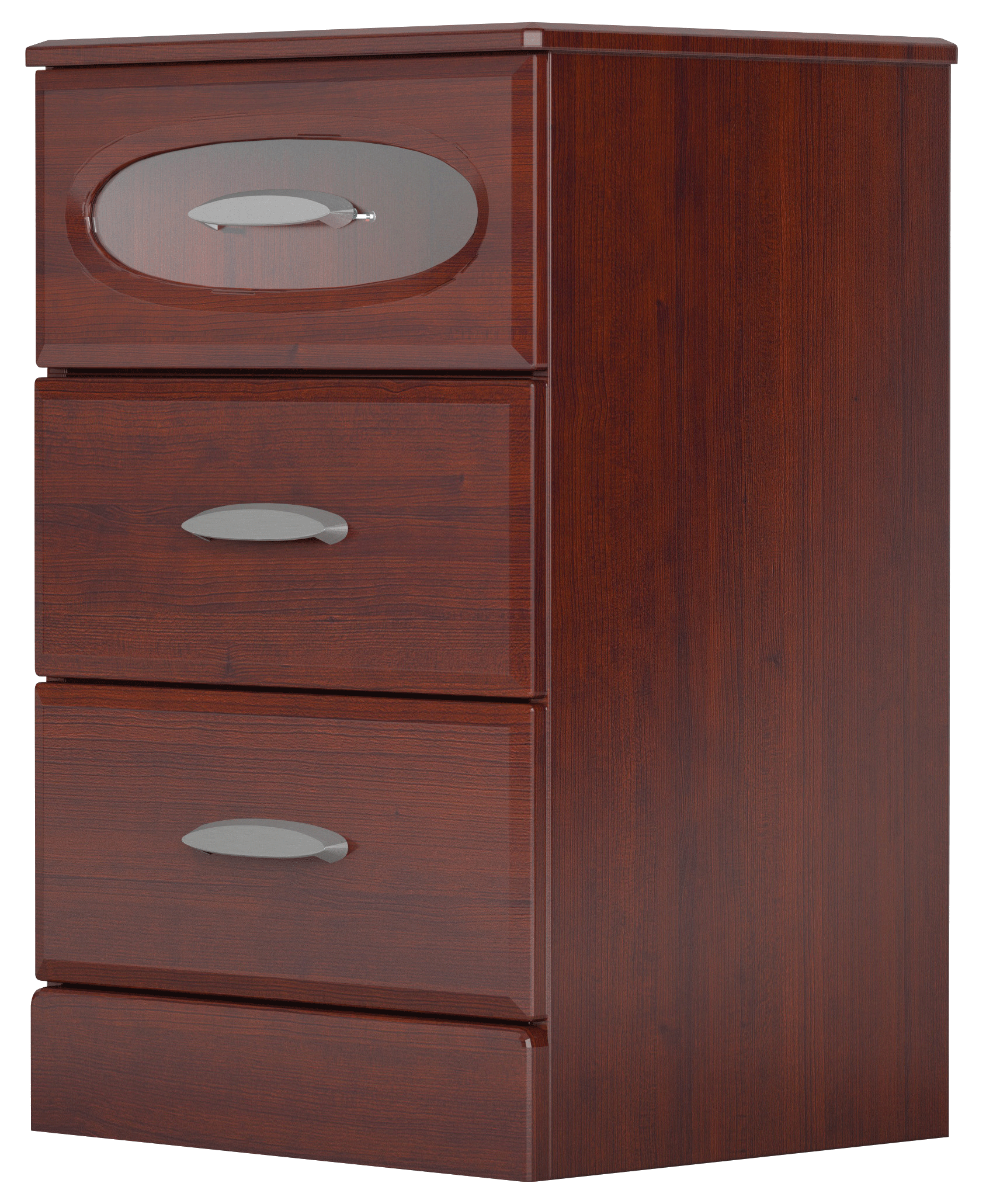
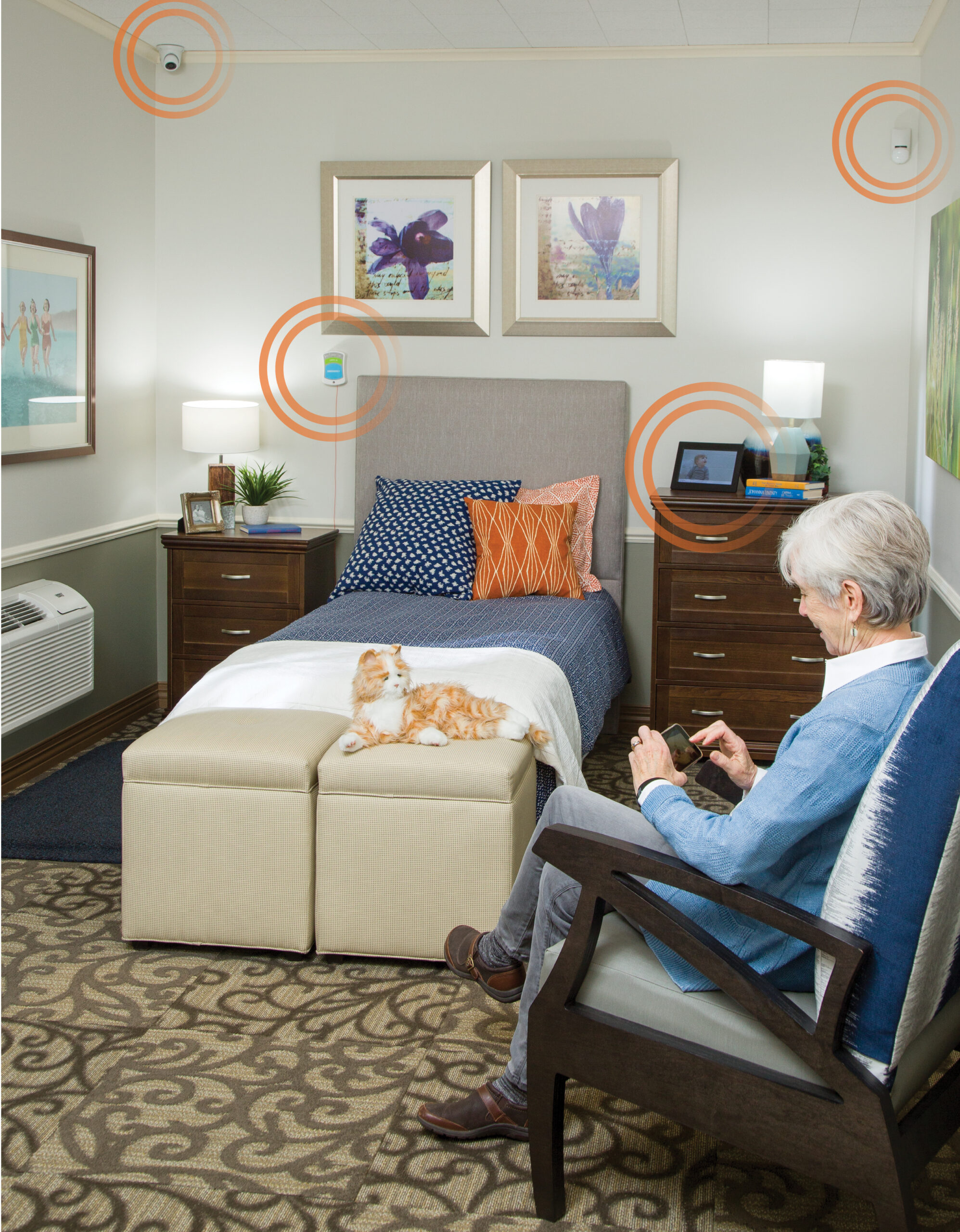
Maxwell Thomas Silverthorne Rocker pictured here.
5. Opt for innovative technology
Design for today and the future by incorporating the latest technology trends into your forward-thinking design.
Consider the use of IoT sensors to add a modern twist to resident living spaces that provide discrete monitoring and help improve staff efficiency. Devices like the The PalCare Motion Sensor can be added to nurse call systems to automate resident check-in, which saves staff valuable time instead of manual wellness checks and allows residents to contribute to their care by simply going about their everyday routines.
Falls Prevention Solutions, like SafelyYou, woven into your senior room design can enhance marketability by delivering peace of mind to families across memory care, assisted living, and skilled nursing care environments. With up to 70% of falls occurring in resident’s bedrooms, they’ll feel safe knowing a smart
Personal electronics, like the latest LED TV’s, bring entertainment and engagement platforms to bedrooms. For shared rooms choose LTC options, like the Continu-us Long Term Care Lite LED HDTV that allows for multiple TV’s to be in use in one room without remote control interference. Also look for TV’s that are 40-43″ to help residents see images more clearly as the television industry moves to larger format displays. Laptops and other electronic devices give a sense of personalization and autonomy. Meet the demand of the Baby Boomer generations and be sure your community has strong Wi-Fi and network connectivity for streaming services and technologies being used in resident bedrooms.
Find more tips for incorporating Senior Living technology into your design.
*Learn more about these stats by visiting SafelyYou’s behind the numbers.
The Bottom Line: Design Tips for Resident Bedrooms
Your residents deserve a peaceful place to call their own — one that they enjoy and that keeps them safe. Our design team is ready to help you get started. Contact us to start refreshing your resident rooms by filling out the form below.
